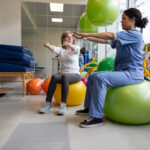Physical therapy is an increasingly popular field with opportunities for growth and change while making a difference in patients’ lives. The first step toward becoming a physical therapist is completing the essential education requirement: obtaining a Doctor of Physical Therapy (DPT) degree, a clinical doctorate demonstrating expertise in human movement.
Physical therapists need this education to properly treat pain, injuries, and movement impairments that affect a patient’s quality of life. For example, these programs focus on patient education, movement exercises, and hands-on therapeutic care to ensure PTs are prepared to help individuals of all ages regain mobility and range of motion, reduce discomfort, and heal from injuries.
Why Enroll in a DPT Program?
Earning a DPT is an essential step if you hope to practice as a licensed physical therapist so it’s important to find an accredited program that provides the knowledge and clinical experience needed to succeed in the field.
In a traditional program, students complete their undergraduate and postgraduate degrees separately. So, after earning a bachelor’s degree in a related field—such as biology, exercise science, health sciences, kinesiology, or physiology—you can obtain a doctorate in three years. Most institutions follow this model because it gives students more time and flexibility to figure out what they want to do and gain experience that will enrich their postgraduate education.
Your DPT program should:
- Increase career mobility
- Add to your credibility in the field
- Provide opportunities to help others
- Enable you to join a growing industry
Five Things to Expect in Your DPT Program
According to Dr. Christopher Cesario, associate clinical professor and director of student affairs for the Doctor of Physical Therapy program at Northeastern University, not all DPT programs are created equal. Here are five things to expect in a DPT program like the one at Northeastern University’s Bouvé College of Health Sciences:
1. Foundational Education
While most accredited DPT programs provide the knowledge and clinical experience needed to succeed in this field, it’s important to consider each program’s prerequisite courses. For example, many programs are tailored to students who already have substantial undergraduate credits in the health sciences. In addition, some schools require GRE exam scores, while others do not. As you compare your options, make sure the curriculum is in line with your personal and professional goals, and you can satisfy the admission criteria.
2. Clinical Education
Clinical education is one pillar of the experiential learning focus that Northeastern University prides itself on.
Look for physical therapy programs that offer in-depth insight into different disciplines through research labs and simulated clinics. Simulated patient encounters are great opportunities to get a feel for the many variables you’ll encounter working as a care provider.
Bouvé students conduct realistic assessments and movement therapies at the institution’s simulation lab, often working with local members of the community. PT students must learn to be attentive to what their clients are experiencing and adapt their treatment plans to get better results. “That really speaks to the co-op education aspect,” Cesario notes. “I think we do that very well here at Northeastern.”
3. Co-op and Internship Opportunities
Co-ops and internship opportunities are another way to gain exposure. At Northeastern’s Bouvé College of Health Sciences, students spend six months on co-op working in physical therapy settings. These paid positions not only give students experience and confidence but allow them to work with different patients in different settings to determine what type of job they want.
4. Synthesize Education into Research Findings
All students in the DPT program at Northeastern University gain valuable research education through multiple courses culminating in the participation in research with a faculty mentor and presentation at the annual NU Research and Innovation Exposition.
Many students also disseminate research findings with faculty through scientific publications and professional conferences.
5. Preparation for the State Licensure Exam
Where you pursue a physical therapy education can have a huge impact on the long-term value of your degree. Be sure you’re joining a program focused on preparing you for the state licensure exam, like Northeastern’s DPT program.
Gaining licensure is achieved by passing the National Physical Therapy Examination (NPTE). Many institutions help throughout this process, but the level of support offered to students to prepare for the NPTE is another factor you should consider when choosing a DPT program.
Choose the Right DPT Program for You
Physical therapy is an incredibly rewarding healthcare profession that many people pursue. Obtaining your Doctor of Physical Therapy (DPT) degree is essential to your growth and success in the profession so it’s crucial to choose a program that will provide the knowledge and experience needed.
A diversified education, like Bouvé’s Post Baccalaureate Doctor of Physical Therapy degree program, will give you the comprehensive knowledge to evaluate complex medical histories and provide high-quality patient care in a variety of settings. From the expert faculty to the experiential learning resources, students gain the tools, support, and skills they need to launch their physical therapy careers with confidence. If you’re interested in learning about enrollment options, contact a Northeastern University admissions counselor for more information about the DPT program.






Related Articles
How To Become A Physical Therapist: 7 Steps
How Much Does A Physical Therapist Make?
7 Types of Jobs in Physical Therapy: Which Is Right For You?